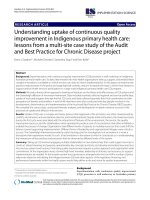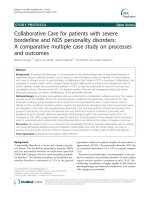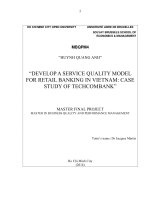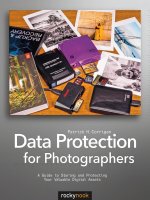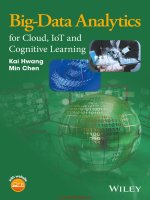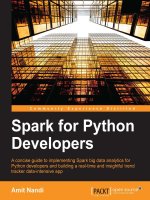LetMeRead.net__CRC.Data.Analytics.for.Pandemics.A.COVID-19.Case.Study.0367558467
Bạn đang xem bản rút gọn của tài liệu. Xem và tải ngay bản đầy đủ của tài liệu tại đây (3.25 MB, 85 trang )
Data Analytics for
Pandemics
A COVID-19 Case Study
Intelligent Signal Processing and
Data Analysis
Series Editor: Nilanjan Dey
Intelligent signal processing (ISP) methods are progressively swapping the conventional analog signal processing techniques in several
domains, such as speech analysis and processing, biomedical signal
analysis radar and sonar signal processing, and processing, telecommunications, and geophysical signal processing. The main focus of this
book series is to find out the new trends and techniques in the intelligent signal processing and data analysis leading to scientific breakthroughs in applied applications. Artificial fuzzy logic, deep learning,
optimization algorithms, and neural networks are the main themes.
Bio-Inspired Algorithms in PID Controller Optimization
Jagatheesan Kallannan, Anand Baskaran, Nilanjan Dey,
Amira S. Ashour
A Beginner’s Guide to Image Preprocessing Techniques
Jyotismita Chaki, Nilanjan Dey
Digital Image Watermarking: Theoretical and Computational
Advances
Surekha Borra, Rohit Thanki, Nilanjan Dey
A Beginner’s Guide to Image Shape Feature Extraction Techniques
Jyotismita Chaki, Nilanjan Dey
Coefficient of Variation and Machine Learning Applications
K. Hima Bindu, Raghava Morusupalli, Nilanjan Dey,
C. Raghavendra Rao
Data Analytics for Coronavirus Disease (COVID-19) Outbreak
Gitanjali Rahul Shinde, Asmita Balasaheb Kalamkar,
Parikshit Narendra Mahalle, Nilanjan Dey
A Beginner’s Guide to Multi-Level Image Thresholding
Venkatesan Rajinikanth, Nadaradjane Sri Madhava Raja,
Nilanjan Dey
Hybrid Image Processing Methods for Medical Image Examination
Venkatesan Rajinikanth, E. Priya, Hong Lin, Fuhua (Oscar) Lin
For more information about this series, please visit: https://www.
routledge.com/Intelligent-Signal-Processing-and-Data-Analysis/
book-series/INSPDA
Data Analytics for
Pandemics
A COVID-19 Case Study
Gitanjali Rahul Shinde
Asmita Balasaheb Kalamkar
Parikshit N. Mahalle
Nilanjan Dey
First edition published 2021
by CRC Press
6000 Broken Sound Parkway NW, Suite 300, Boca Raton, FL 33487-2742
and by CRC Press
2 Park Square, Milton Park, Abingdon, Oxon, OX14 4RN
© 2021 Taylor & Francis Group, LLC
CRC Press is an imprint of Taylor & Francis Group, LLC
Reasonable efforts have been made to publish reliable data and information, but the author
and publisher cannot assume responsibility for the validity of all materials or the conse
quences of their use. The authors and publishers have attempted to trace the copyright
holders of all material reproduced in this publication and apologize to them if permis
sion to publish in this form has not been obtained. If any copyright material has not been
acknowledged please write to us and let us know so we may rectify in any future reprint.
Except as permitted under U.S. Copyright Law, no part of this book may be reprinted,
reproduced, transmitted, or utilized in any form by any electronic, mechanical, or other
means, now known or hereafter invented, including photocopying, microfilming, and
recording, or in any information storage or retrieval system, without written permission
from the publishers.
For permission to photocopy or use material electronically from this work, access www
.copyright.com or contact the Copyright Clearance Center, Inc. (CCC), 222 Rosewood
Drive, Danvers, MA 01923, 978-750-8400. For works that are not available on CCC, please
contact
Trademark notice: Product or corporate names may be trademarks or registered trade
marks, and are used only for identification and explanation without intent to infringe.
ISBN: 9780367558468 (hbk)
ISBN: 9781003095415 (ebk)
Typeset in Times
by Deanta Global Publishing Services, Chennai, India
CONTENTS
Preface
ix
Acknowledgment
xi
Authors
xiii
1
COVID-19 Outbreak
1.1 Introduction
1.2 Epidemic and Pandemic Overview
1.2.1 Stages of Disease
1.2.2 Pandemic Phases
1.2.2.1 Pandemic Risk Factors
1.2.2.2 Pandemic Mitigation
1.2.2.3 Situational Awareness
1.2.2.4 History of Pandemics
1.3 Novel Coronavirus
1.4 Medical Overview – Nature and Spread
1.5 Vulnerability Index
References
1
1
3
3
5
5
5
6
6
7
10
11
12
2
Data Processing and Knowledge Extraction
2.1 Data Sources and Related Challenges
2.2 Data Storage: Platform
2.2.1 Storage Services
2.2.2 Big Data Analytics Services
2.2.3 Data Warehousing Services
2.3 Data Processing
2.3.1 Missing Values Imputation
2.3.2 Noise Treatment
2.4 Knowledge Extraction
15
15
19
20
24
25
26
28
28
29
v
vi
Contents
2.4.1 Knowledge Extraction Based on Data
Types
2.4.1.1 Knowledge Extraction from
Text Data
2.4.1.2 Knowledge Extraction from
Image Data
2.4.1.3 Knowledge Extraction from
Audio Data
2.4.1.4 Knowledge Extraction from
Video Data
2.4.2 Knowledge Extraction Techniques
References
29
29
31
32
32
33
34
3
Big Data Analytics for COVID-19
3.1 All You Need to Know
3.1.1
WEB 2.0
3.1.2
Critical Thinking
3.1.3
Statistical Programming (R/Python)
3.1.4
R Programming Language
3.1.5
Python Programming Language
3.2 Data Visualization
3.2.1 Big Data Analytics and COVID-19
3.2.1.1 Statistical Parameters
3.2.1.2 Predictive Analytics
3.3 Data Models and Performance
3.3.1 Data Modeling Phases
3.3.2 Ensemble Data Model
3.3.3 Model Performance
3.4 Big Data Techniques
3.4.1 Association Rule Learning
3.4.2 Classification Tree Analysis
3.4.3 Genetic Algorithm
3.4.4 Machine Learning
3.4.5 Regression Analysis
3.4.6 Social Network Analysis
3.5 Big Data Tools and Technology
References
37
37
37
38
39
39
40
40
41
41
41
42
43
44
46
46
47
47
48
48
49
49
50
54
4
Mitigation Strategies and Recommendations
4.1 Case Studies of COVID-19 Outbreak: Global
Scenario
4.1.1 COVID-19 Spread in China
4.1.2 COVID-19 Spread in Italy
4.1.3 COVID-19 Spread in the United States
57
57
57
58
58
Contents
4.2
4.3
4.4
Mitigation Strategies and Discussion
Issues and Challenges
Recommendations
4.4.1 Recommendations for Citizens
4.4.2 Recommendations for COVID-19
Suspected and Infected Patients
4.4.3 Recommendations for Hospital
Management: Adults
4.4.3.1 IPC Measures
4.4.4 Recommendations and Caring for
Pregnant Ladies
4.4.5 Recommendations for Quarantine
4.5 Conclusions
4.6 Future Outlook
References
Index
58
60
60
61
61
61
62
63
63
63
65
65
67
vii
PREFACE
“Reshape yourself through the power of your will; never let
yourself be degraded by self-will. The will is the only friend
of the Self, and the will is the only enemy of the Self.”
Bhagwad Gita
This book presents an overview of the recent pandemic of COVID
19 and the role of data analytics in such a pandemic for better pre
dictions and forecasting. COVID-19 has a zoonotic origin, i.e. virus
being transmitted from animals to human. Symptoms of COVID-19
range from a person showing no signs (asymptomatic) to a person
having a severe case of pneumonia. Wuhan, China was the first city to
experience the outbreak of COVID-19. The key to understanding the
pandemic starts with an understanding of the disease itself, and the
progression of the natural course of the disease. The main objective of
this book is to present how machine learning techniques can be use
ful for accurate data analytics, essentially in the context of the recent
COVID-19 pandemic. This book presents the different categories of
the disease and various ways of disease transmissions. The study of
a past pandemic can help us understand the rate of transmission, loss
of human life, and nature of the disease. In this view, various past
pandemics and stages of the pandemics are discussed in this book.
Accurate prediction of spread and infection rate can help to mini
mize this outbreak by taking precautionary measures. However, for
forecasting, data is required and there are various challenges of data
processing. This book presents COVID-19 data sources and their
challenges. Techniques for extracting knowledge from such heteroge
neous data are also presented in this book.
ix
x
PrefaCe
The next part of the book presents various data analytics mod
els and their performance. Different big data techniques like asso
ciation rule learning, Classification tree analysis, genetic algorithm,
and machine learning are discussed with use cases. There are various
parameters i.e. environmental factors, mobility, patient health his
tory, etc., that can impact on spread rate. The categorization of these
parameters is also discussed in this part of the book. The popula
tion with already existing diseases are more prone to COVID-19 and
in the sequel the discussion of the vulnerable population is also dis
cussed in the scope of this book.
The last section of the book presents a brief of global scenario
affecting China, Italy, and the United States, as examples. Issues and
challenges of data analytics regarding pandemics like COVID-19 are
also presented with mitigation strategies that can be implemented.
Recommendations for citizens, patients, and healthcare profession
als are also suggested to overcome COVID-19. Finally, this book
concludes with the open research and practical issues of COVID-19
control and future outlook to minimize the spread rate of COVID-19.
The main characteristics of this book are:
• A concise and summarized description of all topics.
• This book covers the recent pandemic of COVID-19 and pres
ents ML models for predictions.
• Analytical models are explained with use case and scenariobased descriptions. This unique approach will certainly help
readers to a better understanding of COVID-19.
• Issues, challenges, mitigation strategies, and recommendations
are presented in simple terms that can be understood by a lay
man to better educate the public.
• Overall, in this book, analytical strategies of predictions for
COVID-19 are explained in simple and easy terms so that it
can be useful to a wide range of stakeholders, e.g. a layman to
educate researchers, villages to metros and at the national to
global levels.
The book is useful for undergraduates, postgraduates, industry
researchers, and research scholars in the field of data analytics. It is
also useful for the general public as recommendations to avoid wide
spread infections. We are sure that this book will be well received by
all stakeholders.
ACKNOWLEDGMENT
We would like to thank many people who encouraged and helped us
in various ways throughout the publication of this book, namely our
colleagues, friends, and students. Special thanks to our family for
their support and care.
We are thankful to the Honorable founder president of STES, Prof.
M. N. Navale, founder secretary of STES, Dr. Mrs. S. M. Navale,
Vice President (HR), Mr. Rohit M. Navale, Vice President (Admin),
Ms. Rachana M. Navale, our Principal, Dr. A. V. Deshpande, Vice
Principal, Dr. K. R. Borole, Dr. K. N. Honwadkar for their constant
encouragement and inexplicable support.
We are also very much thankful to all our department colleagues
at SKNCOE and Techno India College of Technology and for their
continued support and help and for keeping us smiling all the time.
Last but not the least, our acknowledgments would remain incom
plete if we do not thank the team of CRC Press who supported us
throughout the development of this book. It has been a pleasure to
work with the CRC Press team and we extend our special thanks to
the entire team involved in the publication of this book.
Gitanjali R. Shinde
Asmita B. Kalamkar
Parikshit N. Mahalle
Nilanjan Dey
xi
AUTHORS
Gitanjali R. Shinde has an overall experience of 11 years and is
currently working as SPPU approved Assistant Professor in the
Department of Computer Engineering, Smt. KashibaiNavale College
of Engineering, Pune –. She holds a PhD in Wireless Communication
from CMI, Aalborg University, Copenhagen, Denmark, on Research
Problem Statement “Cluster Framework for Internet of People, Things
and Services” – her PhD was awarded on May 8, 2018. She obtained
her ME (Computer Engineering) and BE (Computer Engineering)
degrees from the University of Pune, Pune, in 2006 and 2012,
respectively. She has received research funding for the project titled
“Lightweight group authentication for IoT” by SPPU, Pune. She has
presented a research article in the World Wireless Research Forum
(WWRF) meeting, Beijing China. She has published 40+ papers in
national and international conferences and journals. She is author of
3 books and is the editor of the book The Internet of Everything:
Advances, Challenges and application, De Gruyter Press.
Asmita B. Kalamkar has 5 years of experience, and is currently
working as SPPU approved Assistant Professor in the Department of
Computer Engineering, Smt. KashibaiNavale College of Engineering,
Pune. She obtained her BE (Computer Engineering) degree, 2013, and
her ME (Computer Engineering) degree from SavitribaiPhule Pune
University, Pune, 2015. She has published 10+ papers in national and
international conferences and journals. She is the author of a book.
Parikshit N. Mahalle obtained his BE in Computer Science and
Engineering from SantGadge Baba Amravati University, Amravati,
xiii
xiv
authors
India, and ME in Computer Engineering from SavitribaiPhule Pune
University, Pune, India. He completed his PhD in Computer Science
and Engineering with a specialization in Wireless Communication
from Aalborg University, Aalborg, Denmark. He was a post-doc
Researcher at CMI, Aalborg University, Copenhagen, Denmark.
Currently, he is working as Professor and Head of the Department
of Computer Engineering at STES’s Smt. KashibaiNavale College
of Engineering, Pune, India. He has more than 20 years of teach
ing and research experience. He is serving as a subject expert in
Computer Engineering, Research and Recognition Committee at
several universities like SPPU (Pune) and SGBU (Amravati).He is
a senior member of the IEEE, ACM member, Life member CSI, and
Life member ISTE. Also, he is a member of the IEEE transaction on
Information Forensics and Security, IEEE Internet of Things Journal.
He is a reviewer for IGI Global – International Journal of Rough
Sets and Data Analysis (IJRSDA), Associate Editor for IGI Global International Journal of Synthetic Emotions (IJSE) and Inderscience
International Journal of Grid and Utility Computing (IJGUC). He
is a Member-Editorial Review Board for IGI Global – International
Journal of Ambient Computing and Intelligence (IJACI). He is
also working as an Associate Editor for IGI Global – International
Journal of Synthetic Emotions (IJSE). He has also remained a tech
nical program committee member for International conferences and
symposia like IEEE ICC, IEEE INDICON, IEEE GCWSN, and
IEEE ICCUBEA.
He is a reviewer for the Springer Journal of Wireless Personal
Communications, reviewer for the Elsevier Journal of Applied
Computing and Informatics, member of the Editorial Review Board
of IGI Global – International Journal of Ambient Computing and
Intelligence (IJACI), member of the Editorial Review Board for the
Journal of Global Research in Computer Science.
He has published more than 150 research publications with more
than 1149 citations and H index 14. He has 5 edited books to his credit
by Springer and CRC Press. He has 7 patents to his credit. He has also
delivered invited talk on “Identity Management in IoT” to Symantec
Research Lab, Mountain View, California. He has delivered more than
100 lectures at the national and international level on IoT, Big Data,
and Digitization. He has authored 11 books on subjects like Contextaware Pervasive Systems and Application (Springer Nature Press),
Design and Analysis of Algorithms (Cambridge University), Identity
Management for the Internet of Things (River Publications), Data
authors
Structure and Algorithms (Cengage Publications), and Programming
using Python – (Tech-Neo Publications MSBTE).
He had worked as Chairman of Board of Studies (Information
Technology), SPPU, Pune. He is working as Member – Board of
Studies (Computer Engineering), SPPU, Pune. He has been a mem
ber of the Board of Studies at several institutions like VIT (Pune),
Govt. College (Karad), Sandeep University (Nashik), Vishwakarma
University (Pune), and Dr. D. Y. Patil International University (Pune).
He has also remained a technical program committee member for
many International conferences.
He is a recognized PhD guide of SSPU, Pune, and is guiding
7 PhD students in the area of IoT and Machine Learning. Recently,
2 students have successfully defended their PhD He is also the recipi
ent of the “Best Faculty Award” by Sinhgad Institutes and Cognizant
Technology Solutions. His recent research interests include
Algorithms, Internet of Things, Identity Management, and Security.
He has visited a few countries like Denmark, France, Sweden,
Germany, Austria, Norway, China, Switzerland, and Singapore.
Nilanjan Dey is an Assistant Professor in the Department of
Information Technology at Techno India College of Technology,
Kolkata, India. He is a Visiting Fellow of the University of Reading,
UK. He was an honorary Visiting Scientist at Global Biomedical
Technologies Inc., CA, USA (2012–2015). He was awarded his PhD
from Jadavpur University in 2015. He has authored/edited more than
75 books with Elsevier, Wiley, CRC Press, and Springer, and published
more than 300 papers. He is the Editor-in-Chief of the International
Journal of Ambient Computing and Intelligence, IGI Global, and
Associate Editor of IEEE Access and the International Journal of
Information Technology, Springer. He is the Series Co-Editor of
Springer Tracts in Nature-Inspired Computing, Springer Nature;
Series Co-Editor of Advances in Ubiquitous Sensing Applications
for Healthcare, Elsevier; Series Editor of Computational Intelligence
in Engineering Problem Solving and Intelligent Signal Processing
and Data Analysis; CRC. His main research interests include medical
imaging, machine learning, computer-aided diagnosis, data mining,
etc. He is the Indian Ambassador of the International Federation for
Information Processing (IFIP) – Young ICT Group.
xv
D ata Analytics for Coronavirus Dise ase
1
COVID-19 OUTBREAK
1.1 I NTRO D U C TI O N
The key to understanding a pandemic starts with an understanding of
the disease itself and the progression of the natural course of the dis
ease. The word “disease” is defined as the state that negatively affects
the body of a living person, plant, or animal. A disease affects the
body because of a pathogenic infection. The natural course of the dis
ease starts before the onset of the infection, after which it progresses
through the pre-symptomatic stage. The last stage is the clinical phase.
In the clinical phase, a patient receives the prognosis of the disease.
After successful treatment of the disease, the patient enters into the
remission stage. Remission refers to a decrease in the symptoms or a
complete disappearance of the disease. The patient needs to strictly
follow instructions given by the doctor during the remission stage. This
will ensure that the disease does not recur. If treatment is not success
ful, the patient can die or be chronically disabled. The following are
some important terms that are used to represent the disease state:
(i) Case-fatality rate: It is defined as the ratio of the number of
patients who die due to the disease to the number of people
affected by it.
(ii) Observed survival rate: It is the prediction of the probability of
survival.
(iii) Relative survival rate: It is defined as the percentage of the
observed survival to the survival rate expectation.
Diseases are mainly categorized into two types:
(i) Congenital diseases
(ii) Acquired diseases
1
2
D ata A naly tics
for
Pandem ics: COVID-19
Congenital diseases exist in the body right from birth. These
diseases are generally activated through genetic disorders, envi
ronmental factors, or a combination of both. These diseases are
generally hereditary, i.e. passed on through generations, for exam
ple, hearing conditions and Down syndrome. In contrast to the for
mer, acquired diseases spread through living organisms. These are
not hereditary.
The acquired disease category is further classified into two types:
(i) Infectious diseases
(ii) Non-infectious diseases
Infectious diseases are induced by pathogens or viruses. They are
also called communicable diseases. As the name suggests, these dis
eases are infectious. It means that if one person has contracted the
infectious disease then the disease can be passed on to another per
son through air, food, water, touch (physical contact), etc. SARS and
SARS COVID-19 are examples of infectious diseases.
Similarly, as the name suggests, non-infectious diseases do not
occur due to any kind of infection. It means that a person with a non
infectious disease will not be able to spread the disease to a healthy
person. Diseases such as cancer and auto-immune disorders are
examples of non-infectious diseases.
Infectious disease can affect a healthy person in two ways.
(i) Direct transmission
(ii) Indirect transmission
When the pathogens travel from a patient to a healthy person with
out any middle carrier, then the transmission is referred to as direct
transmission. Direct transmission can happen in the following ways:
• Coming in contact with the infected person.
• Via droplet infection (coughing, sneezing, and spitting).
• Coming in contact with the soil.
Animal bites are also one of the causes of direct transmission.
Whenever there is a reservoir of infection that can transmit the dis
ease from a patient to a healthy person with a middle agent, then that
transmission is known as indirect transmission. Indirect transmission
can happen in the following ways.
C o v i D -19 o u t b r e a k
• If pathogens are transmitted through food, water, etc., it is
known as vehicle-borne disease.
• If pathogens are transmitted through the air, then it is known
as airborne disease.
• If pathogens are transmitted through contaminated items like
clothing, utensils, books, etc., it is known as fomite-borne disease.
After the diagnosis of the disease comes the most important part: the
treatment. Treatment generally consists of targeting the biochemical
reactions occurring due to pathogens. There are two ways to stop that
reaction so that the infection will not spread:
(i) Prevention
(ii) Cure
Through prevention, symptoms of the infection can be reduced using
painkillers so that patients can be at ease. Preventive measures also
include immunization and vaccination. Through cure, particular
drugs are used to kill the pathogen [1].
1.2 EPI D EM I C A N D PA N D EM I C OVERVI E W
1.2.1 Stages of Dise ase
Before studying the latest pandemic, it is very important to study
basic terminologies associated with the pattern of disease spread.
A diagrammatical overview of stages of the disease is depicted in
Figure 1.1.
(i) Sporadic
When the occurrence of the disease is not regular and is
infrequent, it is termed as sporadic.
(ii) Endemic
When the presence of the disease is constant in a particular
geographical area, it is known as endemic. Endemic turns into
a hyperendemic situation when a high level of disease occur
rence is observed.
(iii) Epidemic
When there is a sudden rise in the number of patients with
the same disease and within a particular area, it is termed as an
epidemic.
3
4
D ata A naly tics
for
Pandem ics: COVID-19
Sporadic
Irregular occurrence
of disease
Endemic
When a presence of disease is constant
and increasing
Epidemic
A disease covering a particular area
Pandemic
A disease covering larger geographical area
Figure 1.1 Stages of the disease.
(iv) Pandemic
When epidemics affect larger geographical areas (including
multiple countries and continents), it is known as a pandemic.
A disease takes the form of an epidemic when the following two con
ditions are met. First is when several people are affected by an illness/
disease that has a similar nature of the disease and the same root
cause, and the second is when the number of infected people rapidly
increase over a period. When the epidemic crosses local boundar
ies and covers a wide geological area at the same time, it becomes a
pandemic. A disease is listed under the category of pandemic because
of its infectious nature. A pandemic does not give any information
about the severity and impact of the disease. It merely states the fact
that people across a wide geographical area are being infected with
the disease.
One more term that is majorly used while studying infectious
diseases is “outbreak.” Outbreak happens when a sudden rise in the
number of patients is observed. Outbreaks can last a few days, weeks,
or months. A pandemic is also sometimes referred to as an outbreak.
C o v i D -19 o u t b r e a k
1.2.2 Pandemic Phases
When the World Health Organization (WHO) declares a pandemic
alert for a disease, it follows six different phases.
• Phase 1: A pathogen/virus that exists in animals has not caused
any kind of infection to humans.
• Phase 2: A pathogen/virus has infected humans.
• Phase 3: Small groups of people or random persons are infected
with the virus.
• Phase 4: Human to human transmission is observed due to the
outbreak at the community level.
• Phase 5: The disease has spread in multiple WHO regions.
• Phase 6: There is an outbreak of the disease in one or more
regions different from the ones enlisted in Phase 5 [2].
1.2.2.1 Pandemic Risk Factors
A combination of spread risk and spark risk plays a primary role in
pandemic risks. The spark risk occurs due to the transmission of the
pathogen from animals to humans. These animals can be domestic
animals or wild animals. The spread of the disease due to domestic
animals is generally confined to densely populated areas. The key
drivers of spark risks are live animal markets, wildlife reservoirs, etc.
[3,4]. The spark risk is usually followed by the spread risk. As the
name suggests, it concerns the transmission of the virus along with
the genetic adaptation of the virus. The spread risk is influenced by
the density of the population in the area, trade pattern, and travel pat
tern of the population [5].
1.2.2.2 Pandemic Mitigation
The most vital thing you can do in a pandemic is to be prepared for
what’s coming and be ready with response teams. These preparations
can be categorized into the following categories:
(i) Pre-pandemic period
(ii) Spark period
(iii) Spread period
The pre-pandemic period, as the name suggests, is the stage before
the pandemic. In this stage, continuous planning, simulation exer
cises, public health training, situational awareness, etc., are covered.
5
6
D ata A naly tics
for
Pandem ics: COVID-19
The spark period is defined as the detection of the initial out
break of the pandemic. In this stage, laboratory confirmation of the
pathogen, contact tracing, quarantine, situational awareness, etc., are
covered.
The spread period is when the WHO globally declares the disease
as a pandemic. In this stage, along with tracing and quarantine, vac
cine or antiviral administration takes place. Treatment and care of
patients is an important part of these three stages. While the vaccine
is developed, there should be close coordination between the public
and private sectors [6,7].
1.2.2.3 Situational Awareness
Situational awareness is having up-to-date information about poten
tial infectious diseases and also knowing how to manage that threat
with the available resources. Situational awareness is a key activity
in the spark period as well as in the spread period. The support from
healthcare facilities, media, and diagnostic facilities is very impor
tant. In this stage, it is important to understand the progression of
pathogens and assemble all the necessary means to stop the spread.
Because of the outbreak, the number of patients can increase within
a short period. This sudden clinical surge should be efficiently man
aged [8].
1.2.2.4 History of Pandemics
Some pandemics stand out in history because of the catastrophe they
have caused. We will study them in three parts. The first part includes
notable pandemics before 1800, the second part covers notable pan
demics in 1900, and the last part includes pandemics after 2000.
The first and one of the worst pandemics witnessed by the world
was in 1347 named the Bubonic plague, also known as the Black
Death pandemic [9]. In the wave of this pandemic, millions of people
lost their lives. In the early 1500 the world witnessed the smallpox
pandemic. The mortality rate was only 50% in some of the communi
ties. This pandemic destroyed many native societies [10,11]. In 1881
the Fifth cholera pandemic occurred. More than 1.5 million deaths
were reported [12]. The statistics are shown with the help of a graph
in Figure 1.2 (a). From the graph, it is visible that Black Death was
one of the worst pandemics witnessed by the world.
In the early 1900, the Spanish flu influenza pandemic occurred.
Twenty to hundred million deaths were reported [13]. In 1950 the
Asian flu influenza happened. A total of 1.5 million deaths were
C o v i D -19 o u t b r e a k
reported [14]. In 1968 the Hong Kong flu influenza pandemic
occurred. A total of 1 million deaths were reported [15]. Finally in
1981, the HIV/AIDS pandemic occurred which claimed 36.7 million
deaths. These pandemics caused a major economy loss [16]. The sta
tistics are shown with the help of a graph in Figure 1.2 (b).
In the 2000s there was a whole new wave of pandemics. Severe
acute respiratory syndrome (SARS) and the Middle East respira
tory syndrome (MERS) were viral diseases. SARS occurred in 2003
which claimed 744 lives [17]. MERS occurred in 2012 which claimed
659 deaths [18]. In 2009 there was the Swine flu influenza pandemic.
It was also known as H1N1. This virus claimed 575,500 lives all over
the world [19]. In 2013 the West Africa Ebola virus pandemic caused
11,323 deaths [20]. The statistics are shown with the help of a graph
in Figure 1.2(c).
From all the figures it is observed that these pandemics are a grave
threat to humanity. The most recent pandemic is the Coronavirus
pandemic (COVID-19). COVID-19 had been declared a pandemic in
January 2020 by the World Health Organization (WHO). In a very
short period, this pandemic has covered a large geographical area.
1.3 N OVEL CO RO N AVI RUS
The word “novel” means unknown or dealing with something new.
From the beginning of the outbreak, extensive efforts are being taken
by scientists and professionals all over the world. These extensive
efforts include identification of the source of COVID-19, transmis
sion pattern of the virus/pathogen, risk factors, disease progression,
healthcare management, etc.
COVID-19 has a zoonotic origin. It means this virus was trans
mitted from animals to humans. Wuhan, China was the first city to
experience the outbreak of this virus. It is considered that bats are
the source of COVID-19. However, the main animal source behind
COVID-19 has not been identified as of today. Also, the identification
of the middle agent has not been done until now. In theory, the middle
agent can be responsible for the spread of the virus from animals to
humans. However, early detection of the cases suggests that most of
the infected patients have acquired the disease from Wuhan; many of
the patients were either working or visiting the city. As the number of
patients began to increase, it was clear that a significant amount of
human to human transmission was taking place. To contain the virus,
Wuhan implemented comprehensive control measures which included
7
8
D ata A naly tics
for
Pandem ics: COVID-19
Statistics
10000000
Death count
10000000
150000
0
Black
Death
1500000
Smallpox
Fifth
Cholera
(a) Statistics from the early 1300s to the late 1800s
Statistics
100000000
100000000
1500000
1000000 36700000
0
Death count
HIV/AIDS
(b) Statistics from the 1900s
Statistics
Death count
744 575,500
1000000
0
659
SARS
11,323
Swine
flu MERS West
influenza
Africa
Ebola
(c) Statistics from the 2000s
Figure 1.2 Statistics of past pandemics.
a complete lockdown of the city. Because of the status of Wuhan city
as a transport hub and the mass movement of the population due to the
Chinese New Year (chunyun), the infection quickly affected the mass
population. The infected count was higher in the city of Wuhan, also
with the highest traffic. When the situation started to take a disas
trous route, Wuhan implemented strict measures to control the spread
of the virus. These measures included the identification of patients
